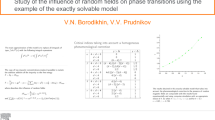Abstract
A system of arbitrarily many nonlinear ordinary differential equations which can be interpreted as describing competition between populations is studied here. It is found that limits exist for the system given specified constraints on the “signal function” which describes input-output relations at the level of single populations. Existence of limits is shown by means of a function which records which variable in the system is growing fastest at a given time i.e. who is winning the competition. Generalizations are discussed to sigmoid signal functions which appear in models of pattern discrimination by neuron populations.
Similar content being viewed by others
Literature
Cronin, J. 1975. “Periodic Solutions inn Dimensions and Volterra Equations”J. Diff. Eqns.,19, 21–35.
Ellias, S. A. and S. Grossberg. 1975. “Pattern Formation, Contrast Control, and Oscillations in the Short Term Memory of Shunting On-Center Off-surround Networks.”Biol. Cyb.,20, 69–98.
Gilpin, M. E. and F. J. Ayala. 1973. “Global Models of Growth and Competition.”Proc. Natn. Acad. Sci., U.S.A. 70, 3590–3593.
Grossberg, S. 1973. “Contour Enhancement, Short Term Memory, and Constancies in Reverberating Neural Networks.”Stud. Appl. Math.,52, 213–257.
— 1976. “On the Development of Feature Detectors in the Visual Cortex with Applications to Learning and Reaction-diffusion Ssytems.”Biol. Cyb.,21, 145–159.
— 1977. “Pattern Formation by the Global Limits of a Nonlinear Competitive Interaction inn Dimensions.”J. Math. Biol.,4, 237–257.
— 1978. “Communication, Memory and Development.” In:Progress in Theoretical Biology, Eds. R. Rosen and F. Snell. New York: Academic Press, p. 183.
— and D. S. Levine. 1975. “Some Development and Attentional Biases in the Contrast Enhancement and Short Term Memory of Recurrent Neural Networks.”J. Theor. Biol.,53, 341–380.
Levine, D. S. and S. Grossberg. 1976. “Visual Illusions in Neural Networks: Line Neutralization, Tilt Aftereffect, and Angle Expansion.”J. Theor. Biol.,61, 477–504.
May, R. M. 1973.Stability and Complexity in Model Ecosystems. Princeton, N. J.: Princeton University Press.
— and W. J. Leonard. 1975. “Nonlinear Aspects of Competition Between Three Species.”SIAM J. Appl. Math.,29, 243–253.
Pierpont, J. 1912.Lectures on the Theory of Functions of Real Variables. Vol. II. Boston: Ginn.
Ratliff, F. 1965.Mach Bands: Quantitative Studies of Neural Networks in the Retina. San Francisco: Holden-Day.
Author information
Authors and Affiliations
Rights and permissions
About this article
Cite this article
Levine, D.S. Existence of a limiting pattern for a system of nonlinear equations describing interpopulation competition. Bltn Mathcal Biology 41, 617–628 (1979). https://doi.org/10.1007/BF02462418
Received:
Revised:
Issue Date:
DOI: https://doi.org/10.1007/BF02462418




